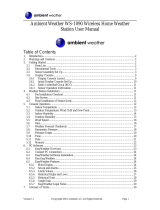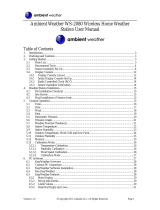Kestrel® 4000 Pocket Weather® Tracker 11
- Ideally, provide an airow of at least 1 M/S (2.2 MPH), over the temperature sensor—point the
Kestrel Meter into the airow. If there is no airow, simply wave the unit back and forth so air
passes over the sensors. With airow over the temperature sensors and humidity chambers,
readings within specications will be provided within two to three minutes, even after a large
temperature shift.
- If no airow can be provided, you must allow sucient time for the RH value to stabilize. This can
take as long as 20 minutes—the greater the temperature change, the greater the time. You can
use the logging capability of the Kestrel Meter to conrm that the unit has stabilized to
a correct reading: Set the memory options to a relatively short logging interval (20 seconds
works well), select the graphical display of RH, and you can see when the value is no longer
changing signicantly. At that point, the RH value is stable and can be relied upon to be within the
accuracy specications.
Barometric Pressure and Altitude Adjustment
The Kestrel Meter measures station pressure—the actual air pressure in the measurement location—and
uses this value to calculate barometric pressure and altitude. Station pressure changes in response to
two things—changes in altitude and changes in the atmosphere. Because the Kestrel Meter is constantly
changing location and altitude, it is important to enter adjustments or “references” when accurate pressure
and altitude readings are needed.
Barometric pressure is station pressure corrected to sea level. In order to make the correction, the Kestrel
Meter needs an accurate reference altitude. Altitude is the height above sea level. In order to correctly
calculate altitude, the unit needs an accurate barometric pressure reference, also known as an “altimeter
setting”. You only need to know ONE of these values (current barometric pressure or current altitude) in
order to set your Kestrel Meter up to show accurate readings.
Starting with the known barometric pressure for your location
You can obtain your current barometric pressure by checking an internet weather site
for a nearby location, or contacting a local airport. Set this value as your reference
pressure on the ALTITUDE screen to determine your correct altitude: Press the button
to enter the reference setting mode. Press the button to increase the reference
pressure or the button to decrease the reference pressure. You will notice that the
altitude will change with changes in the reference pressure. Press the button to exit the adjustment
mode. Set your Kestrel Meter down on a table and allow the altitude reading to stabilize. (Note: very small
changes in pressure generate noticeable changes in altitude. In order to provide meaningful readings for
activities where altitude changes quickly, the Kestrel Meter features rapid altitude response. This is why
the altitude readings tend to uctuate by a few feet.) After obtaining a current altitude from the ALTITUDE
screen, move to the BARO screen and enter this value as your reference altitude by following the same
procedure. Both readings will now be accurate.
Starting with a known altitude for your location
You can obtain your altitude from a topographical map or local landmark. Google Earth
is an excellent free program that provides the exact altitude for any given address:
www.earth.google.com/. Set this value as your reference altitude on the BARO screen
to determine your barometric pressure: Press the button to enter the reference setting
mode. Press the button to increase the reference altitude or the button to
decrease the reference altitude. You will notice that the barometric pressure will change with changes in
the reference altitude. Press the button to exit the adjustment mode. Again, allow the Kestrel Meter to
stabilize, then enter the value from the BARO screen as your reference pressure on the ALTITUDE screen by
following the same procedure. Both readings are now accurate.
Kestrel® 4000 Pocket Weather® Tracker 13
When reviewing stored data, remember that changes in pressure AND changes in location/altitude will
aect the stored values. When tracking pressure changes relative to weather, set the reference altitude on
the BARO screen and keep the Kestrel Meter in one location. Your graph history will now show trends in
barometric pressure. Your altitude as shown on the ALTITUDE screen will change as the weather changes,
but you can ignore this screen for this purpose.
If you are planning a day hike would like to track your altitude, you’ll need to enter the correct reference
pressure on the ALTITUDE screen as described above in “starting with the known barometric pressure.”
You can now track the altitude changes as you hike. In this instance, you should ignore the values on the
BARO screen, since the pressure changes will be due to changes in elevation far more than to changes in
the weather.
In general, changes in barometric pressure associated with weather changes are small over the course of
one day, but they will aect the accuracy of the altimeter over time. This is why aircraft reset their altimeters
at every aireld by entering the eld’s “altimeter setting” or reference pressure. Accordingly, if accurate
altitude readings are your primary interest, you should reset the reference pressure on your Kestrel Meter
regularly. If you encounter an elevation landmark, you can adjust the reference pressure until the altitude
matches the landmark elevation. This will correct the altitude for any pressure changes due to the weather.
(Or, you can obtain an updated reference pressure from the sources described above.)
Some nal notes - If you wish to know the actual or station pressure for your location (such as for engine
tuning), simply set the reference altitude on the BARO screen to “0”. In this case, the Kestrel Meter will not
make any adjustment and will display the measured value.
Also, the above discussion applies to ALL pressure altimeters, including one you may have in a watch or
other device, but not to GPS altimeters, which use satellite triangulation to determine altitude. Note that
with present GPS technology, pressure altimeters remain more accurate for measuring altitude change. This
is why airplanes still rely on pressure altimeters, not GPS.
Finally, the DENSITY ALTITUDE screen is calculated from the absolute values of station pressure,
relative humidity and temperature, and is not aected by the reference values entered in the BARO and
ALTITUDE screens.
MAIN SETUP MENU
You can customize your Kestrel Meter in multiple ways. Press the button to access the Main Setup Menu.
Press the button to select the highlighted setting. The Main Setup Menu contains: OFF, Memory Options,
Measurements, Graph Scale, Units, User Screens, System, Date & Time, Language and Restore.
O
Press the then the button to turn the display o. Even when the Kestrel Meter’s display is turned
o, the unit will continue to automatically store data at the dened Store Rate. The battery life will be
decreased if data is stored frequently. The only way to completely shut o the unit is to remove the
batteries. Custom settings and data will be stored when the batteries are removed.
Memory Options
These settings control the data storage properties.
Setting Description Operation
Clear Log
(Go/Done)
All stored data is cleared. This will also clear
Min/Max/Avg data.
Press or to clear the log.
Reset MMA
(Go/Done)
All Min/Max/Avg data is cleared. Chart data
will remain intact.
Press or to clear the MMA.












